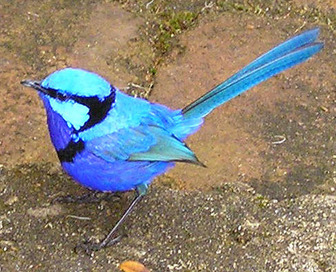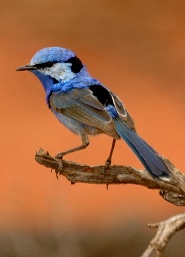Splendid Fairywren
Like other fairywrens, the Splendid Fairywren is notable for several peculiar behavioural characteristics; birds are socially monogamous and sexually promiscuous, meaning that although they form pairs between one male and one female, each partner will mate with other individuals and even assist in raising the young from such trysts.

Original source: splendid fairy-wren
Author: Julia Gross
Splendid Fairywren - Nature's Romeo
 The splendid fairywren (Malurus splendens) is a small breed of bird in the passerine family. Orginally the bird game from Western Australia, though they now live around the country, as far west as New South Wales and as far south as Queensland. Unlike other birds however, the splendid fairywren is not found of humans and are often only found in areas where there are lots of vegetation to protect them.
The splendid fairywren (Malurus splendens) is a small breed of bird in the passerine family. Orginally the bird game from Western Australia, though they now live around the country, as far west as New South Wales and as far south as Queensland. Unlike other birds however, the splendid fairywren is not found of humans and are often only found in areas where there are lots of vegetation to protect them.
When many people think of this breed of bird, they automatically think of a small bright blue creature, similar to the blue jay. This is only partly true. While the male splendid fairywren is bright blue in color, this only happens during breeding. Normally the non-breeding male birds are brown in color, with a blue tail and ears. When the birds are ready to mate, both male and female molt, with males showing their new blue shade. If this alone isn't enough to impress the ladies, male birds have also been known to bring the female flowers. It's not uncommon to see a male gathering pink and purple flower petals to bring home to the females. This is usually done most around mating season, though it's not uncommon for males to do this year round, even while not breeding.
Male splendid fairywren continue this act of wooing the females, even while hunting for food. Like most birds, feed upon small insects, such as ants and spiders. They may also eat bird or flower seeds if they're around, but since these birds dislike human surroundings, they usually make due with what is found in nature. Once this food is found, both male and female will return home to rest and cuddle.
When it comes time to breed, usually in late August through January, the female splendid fairywren builds a round dome like nest out of grass and spiderwebs. These nests are often built close to the ground, but in heavily concealed locations, such as Hakea shrubs. This is to protect them from their main predators of bigger birds, including the gray butcherbirds, kookaburras, ravens and magpies. These birds commonly feed upon the splendid fairywren, though it's not uncommon for the male fairywren to distract the predators in an effort to protect the female.
Unlike most animals, splendid fairywren are socially monogamous. Once a male and a female have fallen in love, they will stay together until they die. Despite this romantic nature, females have no problem being sexually promiscuous, often mating with other males during the breeding season. Two to four eggs are usually laid during the breeding process, with incubation period for the eggs being around two weeks.
Once the babies are born, it is the males, not the females, who raise them. There are usually several male birds who work together to raise the young. While only one of these birds is the biological dad, the males don't seem to mind. The female splendid fairywren on the other hand, watches from afar, assisting only occasionally.
Despite this breeds dislike of humans and their struggles to adjust to urban areas, they're doing well and are currently under no threat of becoming endangered anytime soon. In fact, the splendid fairywren currently ranks "Least Concern" on the conservation status scale, which is the highest any animal can rank.
Picture of the splendid fairywren by Aviceda, licensed under the Creative Commons Attribution-Share Alike 3.0 Unported license.
The Splendid Fairywren is classified as Least Concern. Does not qualify for a more at risk category. Widespread and abundant taxa are included in this category.

Original source: Julia Gross
Author: Julia Gross
Permission: Some rights reserved
Family : Maluridae
Genus : Malurus
Species : splendens
Authority : (Quoy & Gaimard, 1830)

